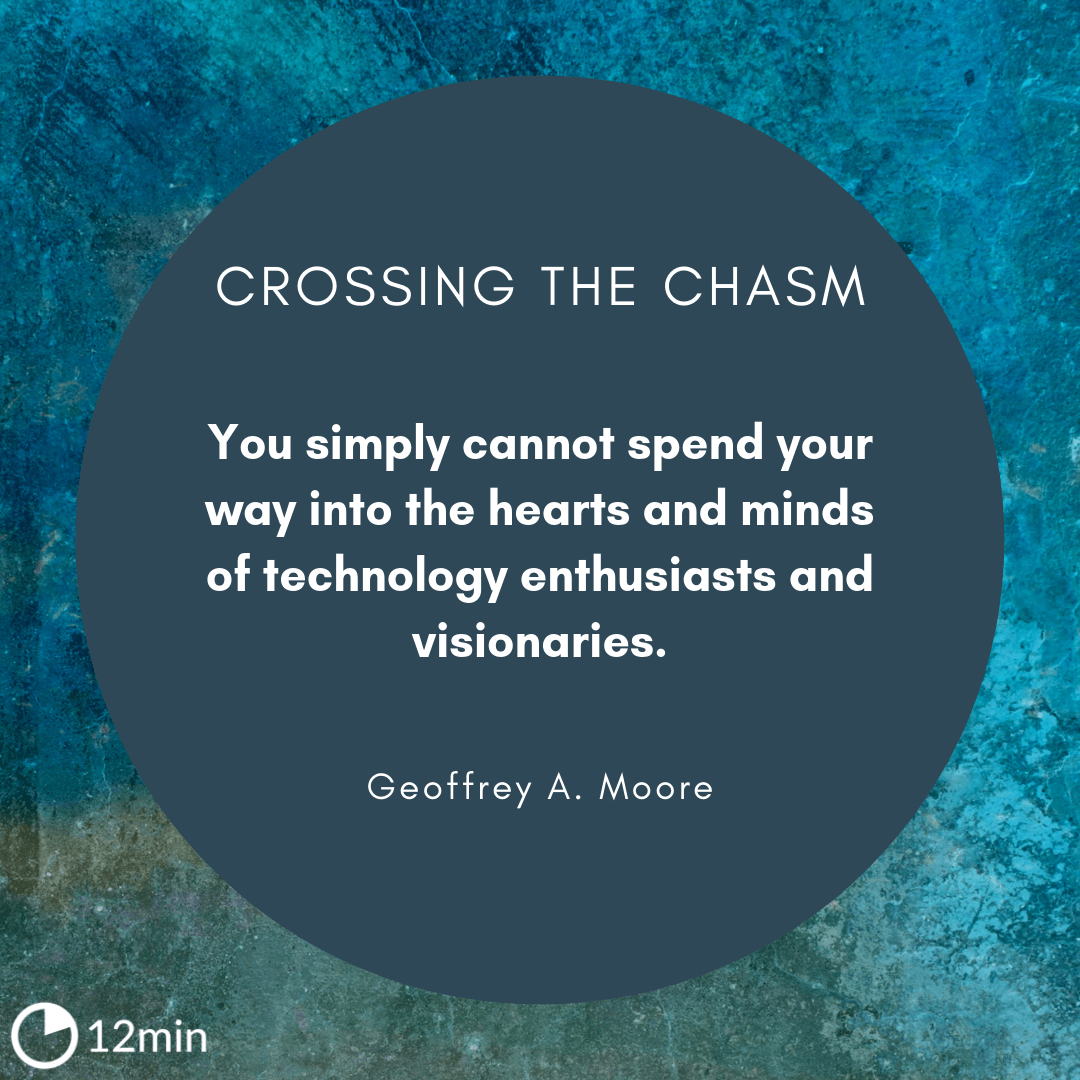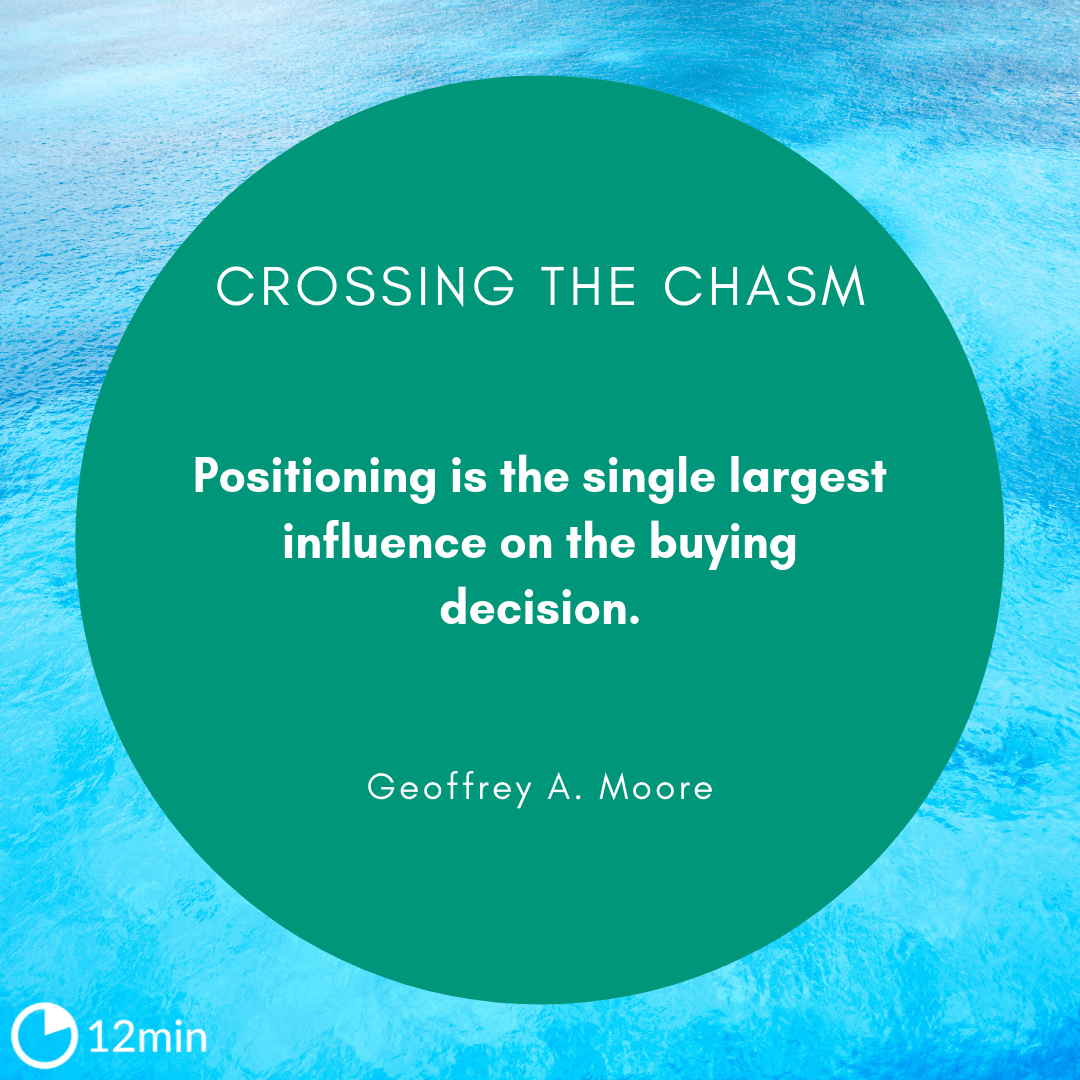Crossing the Chasm Summary

7 min read ⌚
MicroSummary: Published in 1991, “Crossing the Chasm” by Geoffrey A. Moore is still considered a bible for high tech entrepreneurs. It suggests that there is a chasm midway the technology adoption cycle, right between the early adopters (visionaries) and the early majority (pragmatists). And it explicates what a startup should do to cross it.
Crossing the Chasm: Marketing and Selling High-Tech Products to Mainstream Customers
How safe is your high-tech business from the chasm?
Not that safe. To help you assess your current situation, Geoffrey A. Moore wrote Crossing the Chasm. First published at the beginning of the 90’s (now in its 3rd edition), it quickly became the Bible of high-tech entrepreneurship environments and business schools.
As a business graduate myself, I learned that the Technology Adoption Life Cycle is illustrated as a “bell curve” with no disruptions. Just the transition from one category of customers to the other.
Who Should Read “Crossing the Chasm”? And Why?
Apparently, Geoffrey A. Moore has its reasons to write “Crossing the Chasm.” One of them was all the mistakes he witnessed driven by harmful traditional and high-tech professionals. It all depends on reader’s spaciousness and intellect; these two elements are the primary foundation for a successful marketer to build on.
The sad thing is that many advanced technological products cannot cross the “chasm” – they are not able to move from early adopters and expand to mass audiences. The reason for such a situation is the constant need for feedback that the high-tech professionals can hardly ever get.
They need to know consumer’s behavior, how they live, sleep and think. It may seem strange, but Geoffrey main formula for success when launching a brand-new high-tech product or service is to establish an approach with one particular mindset; find the right market and never compete with other high-tech products – rely only on yourself.
This book is intended mostly for new marketers, for people who see future in different marketing industries like self-promotion, e-commerce and high-tech technologies.
About Geoffrey A.Moore
 Geoffrey A. Moore is an American-born organization theorist, manager, consultant and a writer. He was born on July 31, 1946, in Portland, Oregon U.S.A. Moore in 1967 obtained his bachelor degree from Stanford University (American Literature) and seven years later he received a doctorate from the University of Washington (English Literature).
Geoffrey A. Moore is an American-born organization theorist, manager, consultant and a writer. He was born on July 31, 1946, in Portland, Oregon U.S.A. Moore in 1967 obtained his bachelor degree from Stanford University (American Literature) and seven years later he received a doctorate from the University of Washington (English Literature).
Currently, Moore works in a consulting firm as a managing partner located in San Mateo, California, and he is engaged with a capital firm situated in California as well (Menlo Park). His writing career started in the90s and continued to this day.
Till now he wrote: Inside the Tornado; Crossing the Chasm; Living on the Fault Line; and The Gorilla Game.
“Crossing the Chasm Summary”
Usually, no drastic changes are made to the marketing strategy over the course of a product’s evolution until it’s assimilated into the market. Well, what I didn’t know is the different approach that a high-tech product should take in order to reach the same goal.
Geoffrey A. Moore put on paper what his high-tech peers already knew from experience: that between the early market and the mainstream market, a pause in development was happening. And that, ladies and gents, is the chasm. Side note, this threat only appears when we have disruptive innovations.
So… what does “crossing the chasm” entail?
The short answer can be found in this nugget:
“Crossing the chasm—performing the acts that allow the first shoots of that mainstream market to emerge.”
For the long answer, keep reading.
Crossing the Chasm offers real support for both novices and professionals. The author presents arguments as analogies and shows, among other things, the impact and gains of word-of-mouth in a niche market.
Geoffrey Moore, a former English professor, made a shift in his career when he moved across the country from Michigan to California. There, by working in training, sales, and marketing, he created the concept of “the chasm”.
Moore understands what it takes for high-tech innovators to overcome the chasm. After publishing the 1st edition of his highly-acclaimed book, he opened his own consulting agency, Chasm Group.
Geoffrey A. Moore advises you to forget about the visionary approach that the salespeople use to make their offer more appealing. Instead, you should establish a brand by reading the mind of your most trusted customers. This book summary lends you only a small piece of the entire “cake” – use it and start enjoying your success.
After the industrial era, the companies started to see the big picture. Not every person buys a product out of necessity, all customers are different, with thousands of unique preferences that a company must satisfy.
“Crossing The Chasm” talks about several stages that the consumers find themselves into. The first is known as “the early adopters – stage” characteristic of this stage is the customer’s behavior, they are more willing to shift if a better opportunity arises. Initially, people are much less loyal and much more pragmatic though.
As the mutual relationship between a certain company and its clients develops, the firm can learn more about customer’s needs and understand their demands for innovations; which is often not the case, because they are resistant towards change (if they are satisfied). We encourage you to scan this magnificent book enriched with solutions to all kinds of business difficulties.

He realized that:
“The point of greatest peril in the development of a high-tech market lies in making the transition from an early market.”
In its early days of publishing, the book was aimed at business-to-business market development. But, with some alterations, it can be applied to the business-to-consumer markets too.
When Crossing the Chasm first saw the light of day more than two decades ago, the B2B market was the norm for the IT industry. Nowadays, with the rapid expansion of the Internet, the B2C market is in the spotlight.
Moore’s book is split into 7 chapters and two parts.
The first part is about discovering the chasm by addressing the illusion and the enlightenment of the high-tech market.
The second section presents the actionable steps needed for your business to undertake, in order to get through the chasm. Also, at the end, you’ll discover two additions that will help you see the whole picture – in terms of the high-tech market development model and of the remarkable evolution in IT from the last decades.
The key concepts from Moore’s book refer to:
- The Niche Market. To cross the chasm, you need to target a specific niche market where you can dominate from the beginning;
- The WOM. The number-one source of information that buyers use as reference in the high-tech buying process is word-of-mouth;
- The Whole Product. The chasm model affirms that until the whole product is available, your company cannot have a claim to the mainstream market.
- The Positioning. The positioning is more about the mindset of the public than yours;
- The Market Strategy. Each time you make the transition from a category to the next of the Revised Technology Adoption Life Cycle, be sure that you’ve changed your market strategy in a way that fits the specific group of buyers.
As an engineering-oriented entrepreneur one part of the puzzle, when crossing the chasm, consists in managing the birth of the whole product and collaborating with the partners involved in making it happen.
The following list will reveal some tips on how to do it successfully:
- Start with the doughnut diagram while you define and communicate the whole product.
- The whole product needs only its basic requirements. Make sure of this by shredding any unnecessary features when you reexamine it.
- The whole product must be reviewed from each participant’s point of view.
- Take your time, when the whole product relationships are being developed. Get going from the preceding interactions of cooperation towards a more official connection.
- Work as close as possible from where the actual decisions affecting the customers are being made. In the case of sizable partners, work from the bottom up, whereas with the small ones, from the top down.
- Use the official relationships, only as communication initiators.
- Target your drive on establishing alliances at the district sales office level, when working with very large partners. Also, be careful about how you spend your time and effort with grand corporate personnel.
- On the last note, expect that your organization to be the most troublesome partner to handle.

The theories presented by Geoffrey A. Moore in Crossing the Chasm are backed by the IT professionals’ experiences had in the field and based on real case studies.
For example, the Bowling Pin Strategy requires a primary focal point for securing crucial mass in one area and then expanding out from there.
The Revised Technology Adoption Life Cycle represents a graphic description of the chasm, where the names of the groups are unchanged, but the distance between two of them is visibly larger, implying the need of a permanent revision of your marketing plan.
Key Lessons from “Crossing the Chasm”
- Create long-term plan
- It is important for a company to have a well-defined vision
- Retail outlets still hold the number one spot
Create long-term plan
One of the best methods for launching advanced and new high-tech products is to build a long-term plan for expanding to a new audience after the product is being launched. This approach has its risks because it is a complete rarity to find a reliable data.
It is important for a company to have a well-defined vision
Any business can face its downfall or fall into the chasm between separate customer preferences because it’s difficult to satisfy each person separately. The same thing goes when the company lacks money to compete in the market successfully or when the business requires money from external sources to pursue new profitable markets.
Company’s vision represents the basis for creating cost-effective marketing strategies, so it all starts from there.
Retail outlets still hold the number one spot
Distributing high-tech products always had its challenging parts. The traditional way of engaging with the customer relies on direct sales-retail shops, but the modern world opens up new channels and opportunities that a wise marketer must exploit.
Many disagree that the 21st century has found a suitable replacement for retail outlets, even today the best way to create a demand relies on the shoulders of retail. Other channels are tricky with lots of fluctuating strengths.
Like this summary? We’d Like to invite you to download our free 12 min app, for more amazing summaries and audiobooks.
“Crossing the Chasm” Quotes
Is there life after the chasm? Yes. It’s called post-chasm. Share on X
Chasm crossing is not the end, but rather the beginning, of mainstream market development. Share on X
The impact of the chasm extends beyond the marketing organization to every other aspect of the high-tech enterprise. Share on XThe company may be saying “state-of-the-art” when the pragmatist wants to hear “industry standard. Share on X
There is something fundamentally different between a sale to an early adopter and a sale to the early majority, even. Share on XOur Critical Review
We can praise the universal attitude, the details on Silicon Valey and the Digital Age. Nevertheless, just like most books these days, it lacks a dose of creativity which is a common thing for books nowadays.








